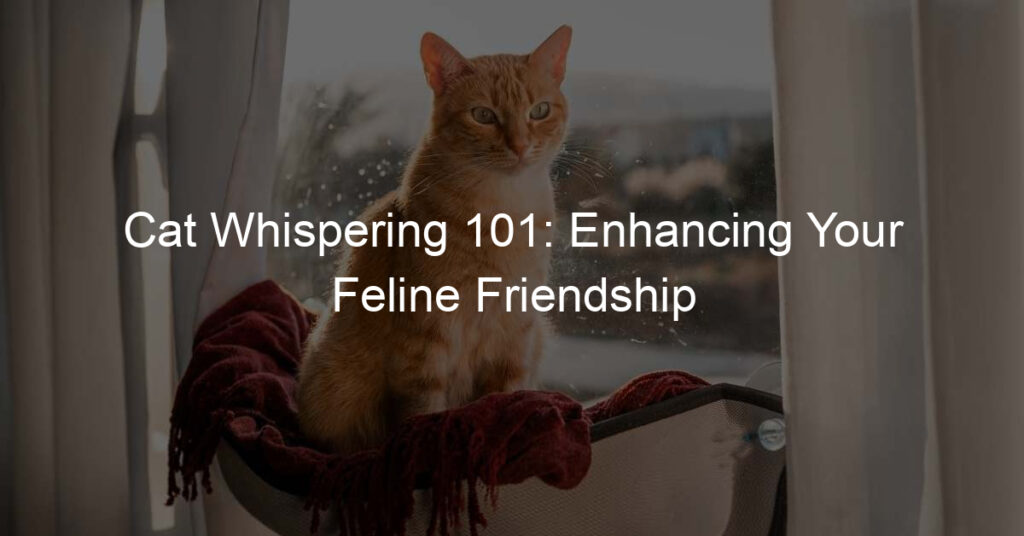
Cat Whispering 101: Enhancing Your Feline Friendship
Have you ever wished you could understand what your cat is trying to tell you? Welcome to Cat Whispering 101, a guide designed to help you enhance your feline friendship. Here, we will explore the art of cat whispering, a skill that can help you build a stronger bond with your furry friend.
What is Cat Whispering?
Cat whispering is the ability to understand and respond to cat behavior in a way that fosters mutual respect and affection. It’s not about training your cat to do tricks, but about learning to communicate effectively with them.
Why is Cat Whispering Important?
Understanding your cat’s needs and behaviors can greatly improve your relationship. Cats are independent creatures, but they also need love and attention. By learning to ‘speak their language’, you can ensure your cat feels understood and cared for.
Key Principles of Cat Whispering
| Principle | Description |
|---|---|
| Observation | Watch your cat’s behavior closely. Notice their body language, vocalizations, and habits. |
| Patience | Cats may take time to trust and open up. Be patient and give them the space they need. |
| Respect | Respect your cat’s boundaries. If they show signs of discomfort, give them space. |
| Consistency | Be consistent in your actions and reactions. This helps your cat understand what to expect from you. |
Benefits of Cat Whispering
Mastering the art of cat whispering can lead to a more fulfilling relationship with your cat. Here are some benefits:
- Improved Communication: You’ll be able to understand your cat’s needs and wants better.
- Stronger Bond: Your cat will trust and feel more comfortable with you.
- Behavioral Improvement: Understanding your cat’s behavior can help address any issues effectively.
In conclusion, cat whispering is a valuable skill for any cat owner. It’s not about controlling your cat, but about understanding them better and building a stronger bond. So, are you ready to become a cat whisperer?
Understanding Cat Behavior
Understanding your cat’s behavior can seem like a mystery at times. However, with a little knowledge and observation, you can learn to recognize common behaviors, interpret body language, and understand vocalizations. This will not only enhance your relationship with your feline friend but also help you identify any potential issues early on.
-
Recognizing Common Cat Behaviors
Cats have a wide range of behaviors that they use to communicate with their human companions. These can include purring when they’re content, hissing when they’re threatened, and kneading when they’re relaxed. It’s important to pay attention to these behaviors as they can provide valuable insights into your cat’s emotional state.
For example, a cat that is constantly scratching furniture or other objects may be trying to mark its territory. On the other hand, a cat that hides or avoids interaction may be feeling stressed or unwell.
-
Interpreting Cat Body Language
Cat body language can be subtle, but once you know what to look for, it can be incredibly revealing. A cat with its tail held high is generally feeling confident and happy, while a cat with a puffed-up tail is likely feeling threatened or scared.
Ears are another important indicator of a cat’s mood. Ears that are held back or flattened against the head can indicate fear or aggression, while ears that are pricked forward show interest or excitement.
-
Understanding Cat Vocalizations
Cats use a variety of vocalizations to communicate with humans. These can range from meows and purrs to hisses and growls. Each sound has a different meaning, and understanding these can greatly improve your communication with your cat.
For instance, a soft, low-pitched meow is often a cat’s way of saying hello, while a loud, high-pitched meow can indicate distress or demand for attention. Similarly, purring usually indicates contentment, but it can also be a sign of discomfort or illness in some cases.
Understanding your cat’s behavior is a key part of building a strong, loving relationship with them. By paying attention to their behaviors, body language, and vocalizations, you can better understand their needs and emotions, leading to a happier and healthier cat.
Cat Behavior Improvement
Improving your cat’s behavior is a crucial part of building a harmonious relationship with your feline friend. This process involves three key steps:
- Identifying problematic behaviors
- Implementing positive reinforcement techniques
- Consulting with a professional if necessary
Identifying Problematic Behaviors
First, it’s important to identify what behaviors are causing issues. Cats can exhibit a range of problematic behaviors, from scratching furniture to refusing to use the litter box. It’s essential to observe your cat closely and note any behaviors that seem out of the ordinary or disruptive.
Implementing Positive Reinforcement Techniques
Once you’ve identified the problematic behaviors, the next step is to implement positive reinforcement techniques. This involves rewarding your cat for good behavior, rather than punishing them for bad behavior. For example, if your cat uses the scratching post instead of the furniture, give them a treat or some extra attention. This will encourage them to repeat the good behavior in the future.
Consulting with a Professional if Necessary
If your cat’s behavior doesn’t improve despite your best efforts, it may be time to consult with a professional. A vet or a professional cat behaviorist can provide valuable insights and strategies to help manage your cat’s behavior. Remember, it’s always better to seek professional help sooner rather than later if you’re struggling with your cat’s behavior.
| Problematic Behavior | Positive Reinforcement Technique |
|---|---|
| Scratching Furniture | Give a treat when the cat uses the scratching post |
| Refusing to Use the Litter Box | Give extra attention when the cat uses the litter box |
| Aggressive Behavior | Play with the cat using toys to redirect aggression |
Improving your cat’s behavior can take time and patience, but with the right approach, you can create a happier and healthier environment for both you and your feline friend.
Cat Relationship Improvement
Improving your relationship with your cat is a rewarding journey. It involves building trust, spending quality time together, and respecting your cat’s boundaries. Let’s dive into each of these aspects.
- Building Trust with Your Cat
- Spending Quality Time Together
- Respecting Your Cat’s Boundaries
Trust is the cornerstone of any relationship, including the one with your feline friend. Building trust with your cat involves understanding their needs and responding to them appropriately. For instance, feeding your cat on a regular schedule can help them feel secure and build trust. Additionally, avoid sudden movements or loud noises that might scare your cat. Remember, trust takes time to build, so be patient and consistent.
Spending quality time with your cat is another crucial aspect of improving your relationship. This could involve playing with them using their favorite toys, grooming them, or simply sitting with them. According to a study, cats that play with their owners have a stronger bond with them. So, make sure to dedicate some time each day to engage with your cat in activities they enjoy.
Just like humans, cats also need their personal space. Respecting your cat’s boundaries means understanding their body language and responding accordingly. If your cat is showing signs of discomfort, such as hissing or flattening their ears, it’s best to give them some space. Similarly, if your cat is sleeping or eating, avoid disturbing them. Respecting your cat’s boundaries can go a long way in strengthening your bond with them.
In conclusion, improving your relationship with your cat involves building trust, spending quality time together, and respecting their boundaries. Remember, every cat is unique, so what works for one might not work for another. The key is to be patient, consistent, and responsive to your cat’s needs.
Repairing Pet Relationships
Repairing relationships between pets can be a challenging task. However, with patience and understanding, it is possible to create a harmonious living environment for your pets. Here are some steps to consider:
- Addressing Aggression Between Pets
- Introducing New Pets to the Household
- Creating a Peaceful Living Environment
Aggression between pets can stem from various sources such as fear, territorial disputes, or a lack of socialization. It’s important to identify the root cause of the aggression to address it effectively. For instance, if your pets are fighting over resources like food or toys, ensure each pet has its own set of resources. If the aggression is due to fear or anxiety, consider consulting with a professional pet behaviorist.
Introducing a new pet to the household should be done gradually and with care. Start by allowing the new pet to explore its new environment without the presence of the existing pets. Gradually introduce the pets to each other, starting with short, supervised interactions. Reward positive behavior with treats and praise to encourage peaceful interactions.
A peaceful living environment is crucial for the wellbeing of your pets. Ensure each pet has its own space where it can retreat and feel safe. Regular exercise and mental stimulation can also help reduce tension and promote peaceful coexistence. Additionally, maintaining a routine can provide a sense of security and reduce anxiety among pets.
Remember, every pet is unique and what works for one may not work for another. It may take time and patience to repair pet relationships, but the result is a peaceful and happy home for all.
| Steps | Description |
|---|---|
| Addressing Aggression | Identify the cause of aggression and address it effectively. |
| Introducing New Pets | Introduce new pets gradually with supervised interactions. |
| Creating Peaceful Environment | Provide each pet with its own space, maintain a routine, and ensure regular exercise and mental stimulation. |
Cat Bonding Tips
Building a strong bond with your cat can be a rewarding experience. Here are some tips that can help you strengthen your relationship with your feline friend.
-
Playing Interactive Games
Playing games with your cat is not just fun, but it’s also a great way to bond. Cats are naturally playful creatures, and engaging them in games can help stimulate their minds and keep them active. Try using toys like balls, feathers, or laser pointers to keep your cat entertained. Remember to always let your cat win the game to boost their confidence.
-
Grooming Your Cat
Grooming is another excellent way to bond with your cat. Regular grooming sessions not only help keep your cat’s fur clean and healthy but also provide a great opportunity for you to spend quality time with your pet. Start by brushing your cat’s fur gently, and over time, you can introduce other grooming activities like nail clipping or ear cleaning.
-
Feeding Your Cat a Balanced Diet
Feeding your cat a balanced diet is crucial for their health and well-being. It shows your cat that you care about their health, which can strengthen your bond. Make sure to include a variety of foods in your cat’s diet, including proteins, grains, and vegetables. Always consult with a vet to ensure you’re providing the right nutrients for your cat’s age, breed, and health condition.
Remember, bonding with your cat takes time and patience. But with these tips, you can create a loving and trusting relationship with your feline friend.
Strengthening Bond with Your Cat
Building a strong bond with your cat is a rewarding experience. It not only enhances your relationship but also contributes to your cat’s overall well-being. Here are some effective ways to strengthen your bond with your feline friend:
- Providing a Safe and Comfortable Space
Just like us, cats need a safe and comfortable space where they can relax and feel secure. This could be a cozy corner in your living room, a soft bed, or a cat tree with multiple levels. Make sure this space is free from loud noises and sudden movements. A study by the American Pet Products Association found that 94% of cat owners reported their cats feeling safer and more relaxed in their designated spaces.
- Understanding and Respecting Your Cat’s Needs
Cats are unique creatures with their own set of needs and preferences. Understanding these needs is crucial in building a strong bond. For instance, some cats may enjoy cuddling, while others may prefer their own space. Respecting these preferences shows your cat that you care about their comfort and happiness. According to a survey by the American Association of Feline Practitioners, cats whose needs were understood and respected by their owners showed higher levels of trust and affection.
- Consistent and Positive Interactions
Consistent and positive interactions are key to strengthening your bond with your cat. This could be through play, grooming, or simply spending time together. Remember to always be gentle and patient, as cats can be sensitive to rough handling. A study published in the Journal of Feline Medicine and Surgery found that cats who had consistent and positive interactions with their owners were more likely to display affectionate behaviors.
Strengthening your bond with your cat takes time and patience, but the rewards are well worth it. By providing a safe space, understanding and respecting your cat’s needs, and having consistent and positive interactions, you can build a strong and lasting bond with your feline friend.
| Tips for Strengthening Bond with Cat | Benefits |
|---|---|
| Providing a safe and comfortable space | Cat feels safer and more relaxed |
| Understanding and respecting cat’s needs | Increased levels of trust and affection |
| Consistent and positive interactions | More likely to display affectionate behaviors |
Cat Communication Tips
Understanding how to communicate with your cat can significantly enhance your bond. Cats use a variety of signals, both vocal and non-vocal, to express their feelings and needs. By learning to interpret these signals, you can communicate more effectively with your feline friend. Here are some tips to help you get started.
- Learning to Understand Your Cat’s Signals
- Communicating Effectively with Your Cat
- Using Vocal and Non-Vocal Communication
Cats use a range of signals to communicate, including body language, vocalizations, and even scent marking. For example, a cat with its tail straight up is usually happy and relaxed, while a cat with its ears flattened is likely feeling threatened or scared. By observing your cat’s behavior closely, you can learn to understand what they’re trying to tell you.
When communicating with your cat, it’s important to be patient and consistent. Use a calm, gentle voice and avoid sudden movements that might startle them. Remember, cats are not humans and they don’t understand language in the same way we do. Instead, they rely on tone of voice, body language, and other non-verbal cues to understand your intentions.
Cats use both vocal and non-vocal communication. Vocal communication includes meowing, purring, hissing, and growling, while non-vocal communication includes body language, facial expressions, and scent marking. By paying attention to both types of communication, you can gain a deeper understanding of your cat’s feelings and needs.
In conclusion, understanding cat communication is a key part of building a strong bond with your feline friend. By learning to interpret your cat’s signals and communicating effectively, you can create a happier, healthier relationship with your cat.
| Cat Signal | Meaning |
|---|---|
| Tail straight up | Happy and relaxed |
| Ears flattened | Feeling threatened or scared |
| Purring | Contentment, but can also indicate discomfort or stress |
| Hissing | Anger or fear |








